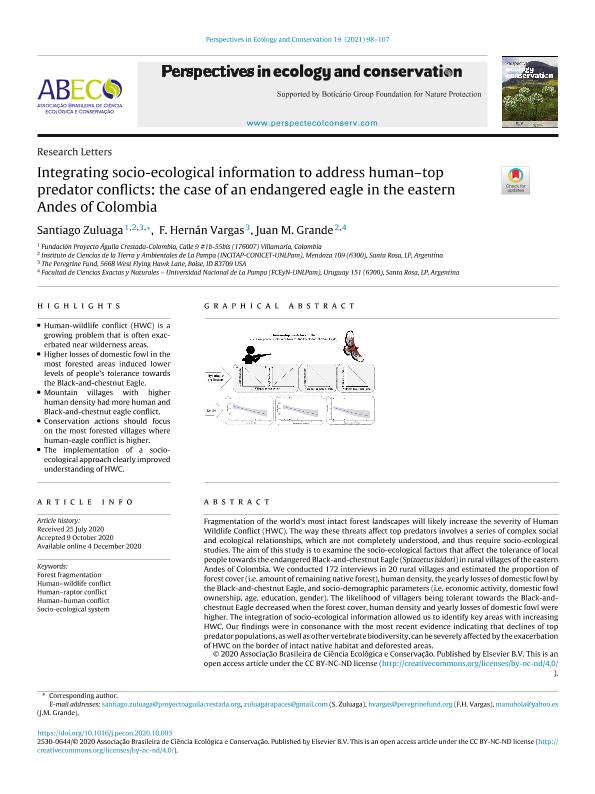Mostrar el registro sencillo del ítem
dc.contributor.author
Zuluaga Castañeda, Santiago

dc.contributor.author
Vargas, F. Hernán
dc.contributor.author
Grande, Juan Manuel

dc.date.available
2023-01-06T16:20:36Z
dc.date.issued
2021-01
dc.identifier.citation
Zuluaga Castañeda, Santiago; Vargas, F. Hernán; Grande, Juan Manuel; Integrating socio-ecological information to address human–top predator conflicts: the case of an endangered eagle in the eastern Andes of Colombia; Elsevier; Perspectives in Ecology and Conservation; 19; 1; 1-2021; 98-107
dc.identifier.issn
2530-0644
dc.identifier.uri
http://hdl.handle.net/11336/183762
dc.description.abstract
Fragmentation of the world's most intact forest landscapes will likely increase the severity of Human Wildlife Conflict (HWC). The way these threats affect top predators involves a series of complex social and ecological relationships, which are not completely understood, and thus require socio-ecological studies. The aim of this study is to examine the socio-ecological factors that affect the tolerance of local people towards the endangered Black-and-chestnut Eagle (Spizaetus isidori) in rural villages of the eastern Andes of Colombia. We conducted 172 interviews in 20 rural villages and estimated the proportion of forest cover (i.e. amount of remaining native forest), human density, the yearly losses of domestic fowl by the Black-and-chestnut Eagle, and socio-demographic parameters (i.e. economic activity, domestic fowl ownership, age, education, gender). The likelihood of villagers being tolerant towards the Black-and-chestnut Eagle decreased when the forest cover, human density and yearly losses of domestic fowl were higher. The integration of socio-ecological information allowed us to identify key areas with increasing HWC. Our findings were in consonance with the most recent evidence indicating that declines of top predator populations, as well as other vertebrate biodiversity, can be severely affected by the exacerbation of HWC on the border of intact native habitat and deforested areas.
dc.format
application/pdf
dc.language.iso
eng
dc.publisher
Elsevier

dc.rights
info:eu-repo/semantics/openAccess
dc.rights.uri
https://creativecommons.org/licenses/by-nc-nd/2.5/ar/
dc.subject
FOREST FRAGMENTATION
dc.subject
HUMAN–HUMAN CONFLICT
dc.subject
HUMAN–RAPTOR CONFLICT
dc.subject
HUMAN–WILDLIFE CONFLICT
dc.subject
SOCIO-ECOLOGICAL SYSTEM
dc.subject.classification
Conservación de la Biodiversidad

dc.subject.classification
Ciencias Biológicas

dc.subject.classification
CIENCIAS NATURALES Y EXACTAS

dc.title
Integrating socio-ecological information to address human–top predator conflicts: the case of an endangered eagle in the eastern Andes of Colombia
dc.type
info:eu-repo/semantics/article
dc.type
info:ar-repo/semantics/artículo
dc.type
info:eu-repo/semantics/publishedVersion
dc.date.updated
2022-09-30T17:56:48Z
dc.journal.volume
19
dc.journal.number
1
dc.journal.pagination
98-107
dc.journal.pais
Países Bajos

dc.journal.ciudad
Amsterdam
dc.description.fil
Fil: Zuluaga Castañeda, Santiago. Consejo Nacional de Investigaciones Científicas y Técnicas. Instituto de Ciencias de la Tierra y Ambientales de La Pampa. Universidad Nacional de La Pampa. Facultad de Ciencias Exactas y Naturales. Instituto de Ciencias de la Tierra y Ambientales de La Pampa; Argentina. Fundación Proyecto Águila Crestada-Colombia; Colombia. Peregrine Fund; Estados Unidos
dc.description.fil
Fil: Vargas, F. Hernán. Peregrine Fund; Estados Unidos
dc.description.fil
Fil: Grande, Juan Manuel. Consejo Nacional de Investigaciones Científicas y Técnicas. Instituto de Ciencias de la Tierra y Ambientales de La Pampa. Universidad Nacional de La Pampa. Facultad de Ciencias Exactas y Naturales. Instituto de Ciencias de la Tierra y Ambientales de La Pampa; Argentina
dc.journal.title
Perspectives in Ecology and Conservation
dc.relation.alternativeid
info:eu-repo/semantics/altIdentifier/url/https://www.sciencedirect.com/science/article/pii/S2530064420300602
dc.relation.alternativeid
info:eu-repo/semantics/altIdentifier/doi/https://doi.org/10.1016/j.pecon.2020.10.003
Archivos asociados
